Planning permission for external wall insulation
Planning permission is usually required for external wall insulation to existing dwellings.
When is planning permission required?
Planning permission is usually required for external wall insulation to existing dwellings.
This is because there is a condition in the General Permitted Development Order that states:
"The materials used in any exterior work…shall be of a similar appearance to those used in the construction of the exterior of the existing dwelling-house.”
However, there are examples where EWI is given a ‘brick slip’ effect which means that the condition above is complied with. For example:
Does not need permission (of similar appearance)
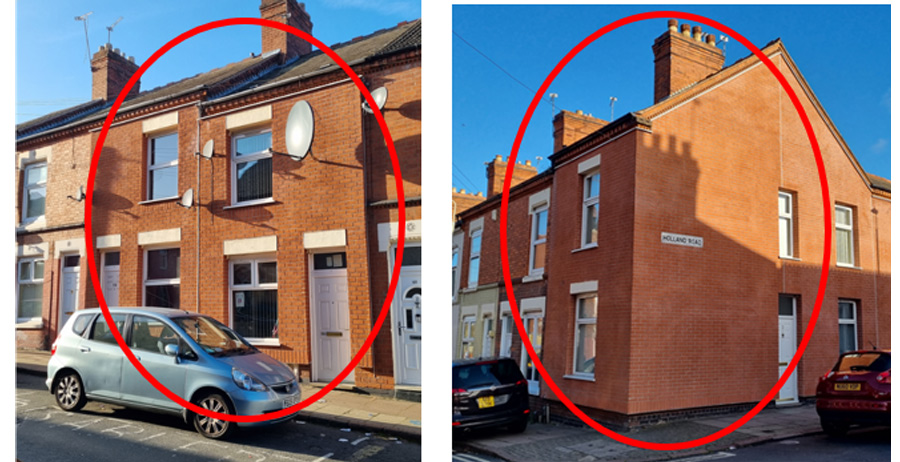
Needs permission (not of similar appearance)
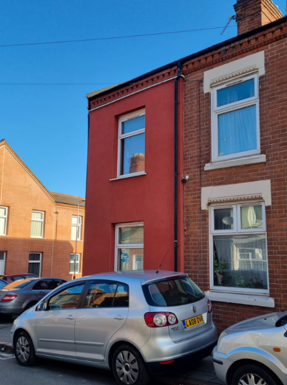
Domestic properties in Leicester that are nationally listed, locally listed or are in conservation areas will always need planning permission for external wall insulation.
Alternative solutions
Before you look to install external wall insulation it is worth first considering the two alternative solutions below:
Internal wall insulation
Can do the same job as external wall insulation and is carried out either by fitting rigid insulation boards (typically 60 – 100 mm) to the wall, or by building a stud wall filled in with insulation material such as mineral wool fibre. It is generally cheaper to install than external wall insulation (if viewed as an isolated measure). This solution is particularly appropriate to terraced properties.
Hybrid
A combination of external wall and internal wall insulation is possible. This is especially relevant for properties in conservation areas or where the outside appearance of the property cannot be changed. External wall insulation would be installed to the back of the property, and internal wall insulation to the front. Technical design considerations are required to avoid cold bridging and installation would involve 2 different work teams. This solution is also particularly appropriate to terraced properties.
What we will consider in a planning application
The key planning policies that are relevant to the installation of external wall insulation are:
- Saved City of Leicester Local Plan policy PS10 ‘Residential Amenity and New Development’
- Core Strategy Policy CS02 ‘Addressing Climate Change and Flood Risk’
- Core Strategy Policy CS03 ‘Designing Quality Places’
- Core Strategy Policy CS18 ‘Historic Environment’ (where relevant)
You can access these policies on the Adopted planning policy page.
When designing your EWI installation you should ensure:
- the works do not erode the unity and coherence of the existing street scene, (including terraced streets with distinctive original features). The works should preserve and reflect the character of the building and street scene
- the works would not result in the loss of attractive and/or original features of the host property. Architectural detailing should be retained, replicated or referenced and the colour of the EWI finish and the texture of the finish should be appropriate. (architectural detailing could include cills, lintels, eaves and decorative brick detailing, quoins arch and cornice detailing bay window and door surrounds and date plaques)
- EWI is unlikely to be acceptable to heritage assets especially on key, protected elevations.
- consideration should also be given to any impacts EWI may have on the use of pavements or the storage of bins
- consideration should also be given to how gutters and pipes are accommodated in altered external frontages.
A separate highways/scaffolding license is required for applications that encroach on to the public footway.
Possible solutions
Poorly designed insulation
These two examples show how by installing plain render the architectural detailing (such cills, lintels, decorative banding across the centre and detailing around the doors) and the character and appearance of the properties are lost having a harmful unacceptable impact on the character and appearance of the wider area:

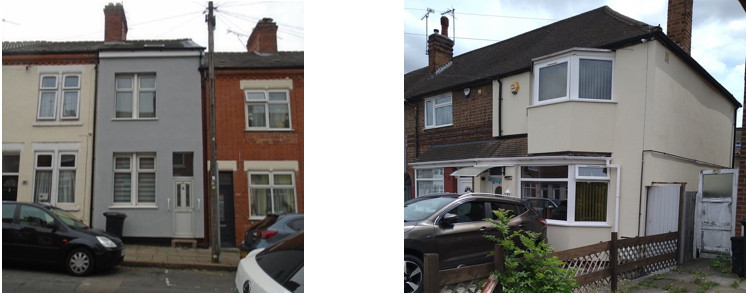
Well designed insulation
However, there are a number of small practical measures that can transform an otherwise harmful and unacceptable finish to well designed finish - that helps to contribute to the character and appearance of the area.
Some of these measures are covered in more detail below:
Note: The solutions below are not suitable for all properties and we advise that in the first instance you seek pre-application advice on what would be suitable for your property.
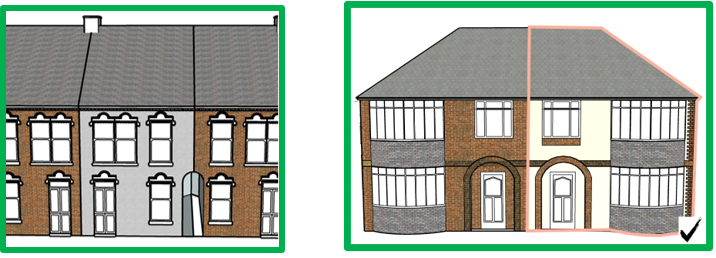
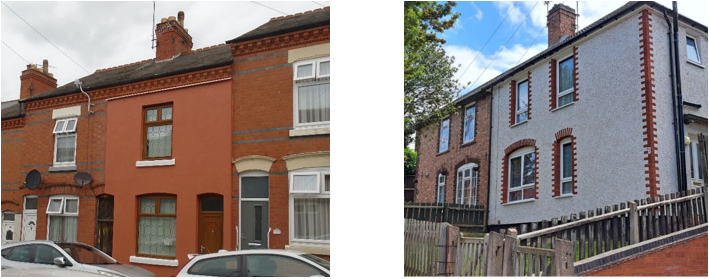
Example of successful solutions
Brick slip finishes
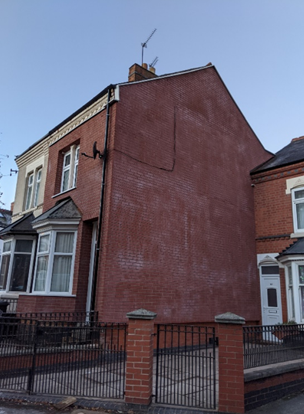
Above - finished with brick slips in a mixed hue finish with eaves detailing replicated.
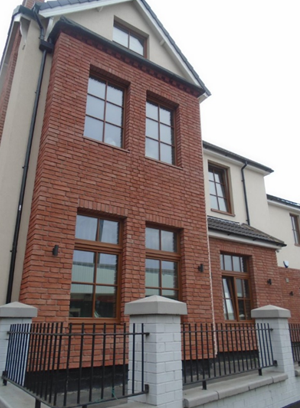
Above - finished with a balanced contrast with brick slips and plain smooth render.
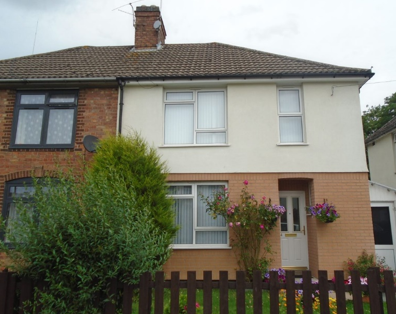
Above - finished with half brick slip and half plain smooth render above.
Use of brick slips to retain character/detailing

Two examples of external wall insulation finished in pebble dash render with carefully positioned brick slips to retain character/detailing of the area.

Brick slips for door surround, central banding and lintels.

Brick slips for corner detailing, window surrounds and lintels.

Detail of pebble dash and brick slip finish.

Brick slips for corner detailing.

Brick slips for door surround.

Brick slips for arch above door.
Solutions for plainer terraced properties
(Note: in many cases the detailing of front elevations of Victorian and Edwardian terraces is such that only internal wall insulation is appropriate).

Eaves detailing left exposed, ii) cill detailing replicated, iii) colour of render in keeping with red brick characteristic of the area.

Paint work for lintels reflects the shape of adjacent lintels, ii) the contrast in paint colour is in keeping with the design of adjacent lintels.

Cut away external wall insulation and render to reveal existing features.
Other solutions

Mock timber front facing gable replicated (not suitable for all properties).
Application submission requirements
All applications for planning permission should be made via the Planning Portal.
Applications will need to be accompanied by:
- Application form
- Location Plan
- Planning Application fee of £206
- Existing and proposed elevations (to a recognised scale)
- A section drawing showing the full length of the front elevation
- Details of material finish (including manufacturer’s specifications)
- Details of colour finish (including manufacturer’s specifications)
- Existing and proposed width of public footway (this can be included on site plan)
- Existing and proposed width of alleyway (this can be included on site plan)
- Details of how guttering and other rainwater goods will be dealt with
In addition, heritage related applications will require a heritage statement, and listed building applications will require a methodology for the installation of external wall insulation.
For any further information on planning requirements we recommend you submit a pre-application enquiry.